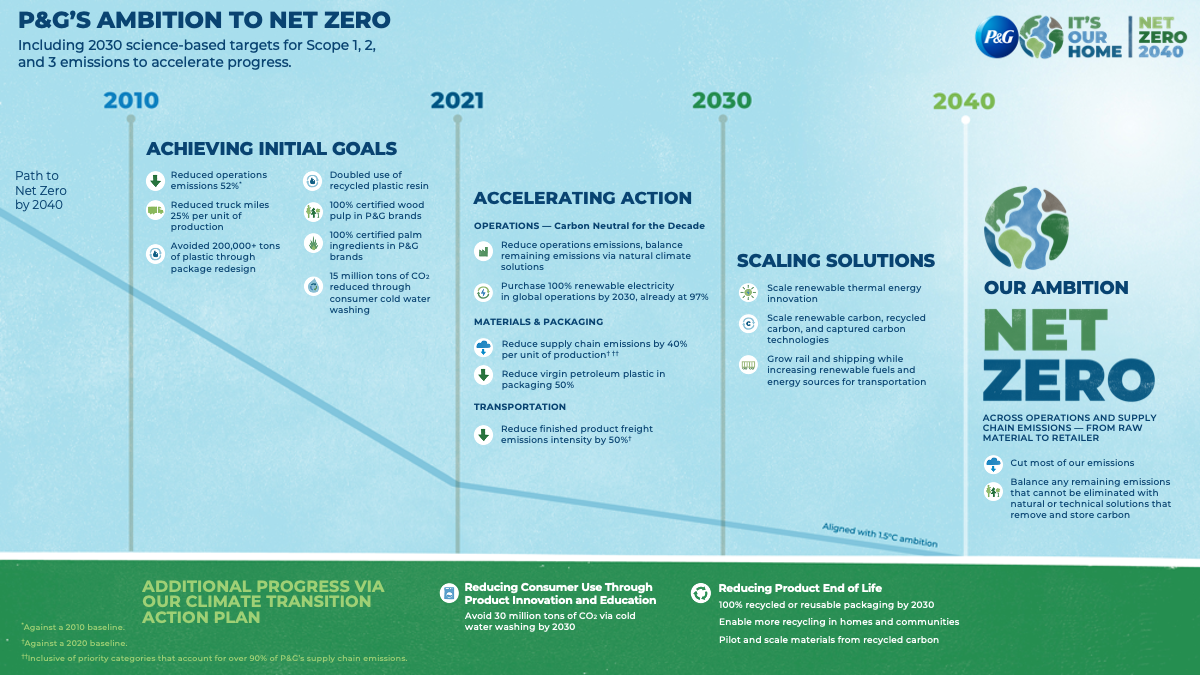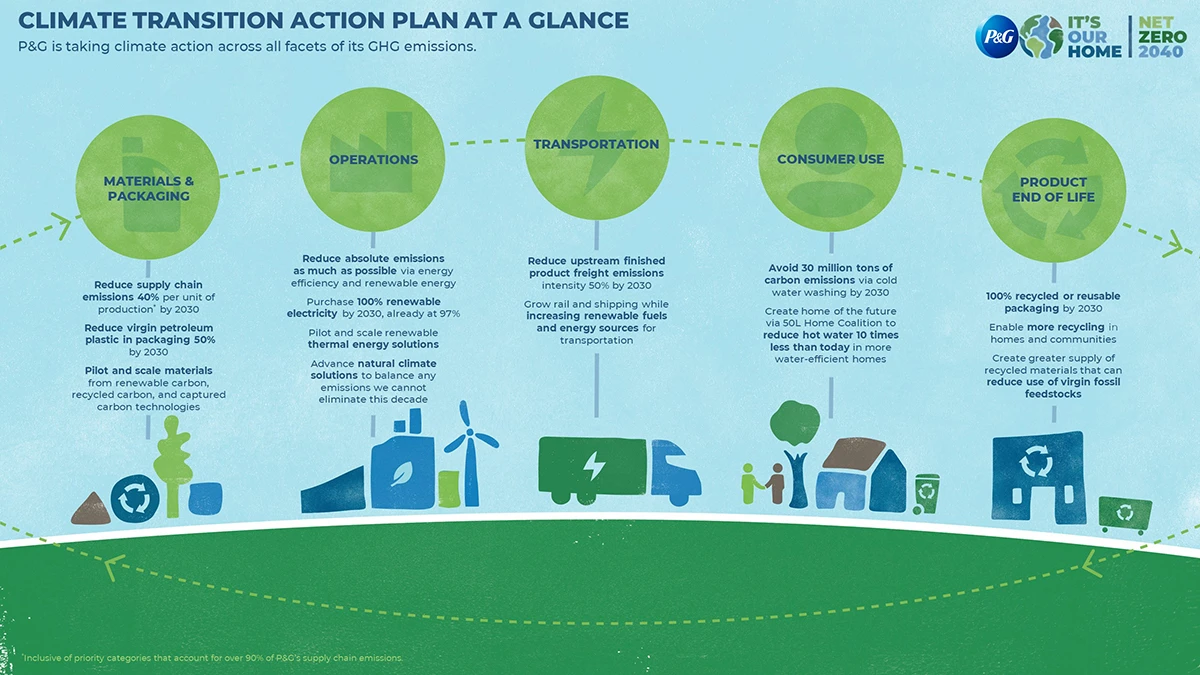2021-09-15
P&G Accelerates Action on Climate Change to Reach Net Zero GHG Emissions by 2040

Today, we announced a comprehensive plan to accelerate action related to climate change. P&G has also set a new ambition to achieve net zero greenhouse gas (GHG) emissions across our operations and supply chain, from raw material to retailer, by 2040 as well as interim 2030 goals to make meaningful progress this decade.
The climate crisis affects every home and family, everywhere in the world, and the latest science has made it clear that decisive action must be taken to avoid the most significant impacts of climate change.
“We are fully committed to use P&G’s innovation and ingenuity to unlock new solutions to address climate change,” said David S. Taylor, Chairman, P&G President and Chief Executive Officer. “The task ahead of us is urgent, difficult and much bigger than any single company or country. P&G is tackling these challenges head-on by reducing our footprint and leveraging our scale to foster unprecedented collaboration across our value chain.”
Our science-based plan to net zero will prioritize cutting most of our emissions across our operations and supply chain, from raw material to retailer. For residual emissions that cannot be eliminated, we will use natural or technical solutions that remove and store carbon.
Our 2030 goals to pace our progress toward net zero were validated by The Science Based Targets initiative (SBTi):
• Reducing emissions across our operations by 50%
• Reducing emissions across our supply chain by 40%1 (from raw material to retailer distribution)

We have joined the UN’s Race to Zero and Business Ambition for 1.5°C campaigns and are also sharing our new Climate Transition Action Plan, which outlines a comprehensive approach to accelerating climate action and the key challenges ahead. A more detailed overview of the plan is available at https://us.pg.com/blogs/net-zero-closer-look/. We will continue to communicate our successes and setbacks along the way so others can learn with us and advance collective progress.
“We don’t have all of the answers on how to bring a net zero future into focus, but we will not let uncertainty hold us back,” said Virginie Helias, P&G Chief Sustainability Officer. “To achieve these goals, we will leverage existing solutions and seek transformative new ones that are not available in the marketplace today. This will require partnership across the private, nonprofit, and public sectors and involve every aspect of our business, from the very beginning of our products’ lifecycle to the very end.”
Acting with Urgency to Reduce Emissions
Our top priority is to significantly reduce GHG emissions across every part of our business as quickly as possible with solutions that exist today.
• Reducing emissions across our operations. From 2010 to 2020 we have reduced absolute emissions across our global operations 52% through energy efficiency and renewable electricity, while still growing our business. As we continue to reduce emissions, we are also advancing natural climate solutions to balance any residual emissions from our operations that cannot be eliminated by 2030. These include new projects that help protect and restore forests and other ecosystems essential to the people and wildlife that call them home.
• Accelerating renewable electricity. We are nearing our 2030 goal of purchasing 100% renewable electricity by increasing global use to 97%. In 2021, the United States Environmental Protection Agency recognized P&G as #5 on its National Top 100 list of green power users and #2 on its Top 30 list for on-site renewable power generation nationwide, making us top-rated in the consumer products industry.
• Decarbonizing our supply chain and logistics. Our supply chain and logistics emissions from raw material to retailer are about 10 times that of our operations and we have set a goal to reduce emissions 40%1 by 2030. We are also planning to increase transportation efficiency of outbound finished products 50% by 2030. Pampers has already reduced one million metric tons of CO2 from its supply chain over the past decade and is actively working with suppliers on further reductions. P&G established a new Product Supply Innovation Center (PSIC) in Kronberg, Germany as a hub for a network of local suppliers, tech companies, and top universities, developing solutions that are global and scalable to help decarbonize our supply chain.

Tackling Challenges by Inventing New Solutions
We know there are some emissions we cannot eliminate yet and our teams are working hard to develop the next generation of low-carbon technologies and materials. Our efforts in this area include:
• Leveraging renewable thermal energy. We use geothermal, solar, and renewable steam at some manufacturing sites, but continuing to reduce emissions will require more innovation. We have partnered with the World Wildlife Fund, manufacturers, and local governments to create the Renewable Thermal Collaborative to identify and scale renewable, cost-competitive thermal energy solutions. “Thermal energy represents a significant challenge for many industries as they chart a path towards net zero,” said Sheila Bonini, Senior Vice President, Private Sector Engagement, World Wildlife Fund. “The Renewable Thermal Collaborative can help unlock scale solutions. P&G is a founding member of the RTC and we appreciate their leadership in this space.”
• Advancing low-carbon technologies. To unlock new ways to decarbonize our supply chain, we are partnering to advance innovation in materials derived from bio-based and recycled carbon and exploring carbon capture and storage to help enable a net zero supply chain.
• Exploring Ingredients made from captured CO2. Our Tide brand is working with Twelve, a Silicon Valley start-up, to explore their carbon capture technology to incorporate CO2 from emissions into ingredients that could be used across Tide.
Creating a Decarbonized Future Through Transformative Collaboration
We are doing more to make a collective impact - partnering with consumers to reduce GHG emissions from the use phase of products, creating alliances for carbon-efficient homes, and advocating for policy solutions to decarbonize energy infrastructure. Our efforts here include:
• Making sustainability effortless at home. P&G and its brands will continue to provide consumers with tools and information on how small actions at home can make a world of difference for the planet.
• Reducing 15 million tons of carbon through cold water washing, and doubling impact with an additional 30 million tons by 2030. We have leveraged innovation and sustained consumer education to help reduce the largest portion of our carbon footprint – the energy needed to heat water during product use. Since 2015, P&G brands Tide and Ariel have helped consumers increase their use of low-energy laundry cycles to avoid roughly 15 million metric tons of carbon dioxide. Tide and Ariel continue to drive greater use of cold water washing through new education campaigns to help avoid an additional 30 million tons of carbon emissions by 2030 – more than ten times that of P&G’s yearly global operations.
• Creating the home of the future. We are advancing solutions to make everyday living more sustainable, with industry partners via the 50L Home Coalition. By helping people reduce hot water use without trade-offs, the Coalition is creating more efficient homes that can use 10 times less water than most use today.
“Caring for our consumers and our planet is core to all of us at P&G,” Taylor added. “There is no action too small, and no vision too big, as we all work together to preserve our shared home for generations to come.”
For more detailed information about P&G’s commitments and progress, please see P&G’s Climate Transition Action Plan and “A Closer Look at Our Net Zero Commitment” blog post. To learn more about P&G’s ESG efforts, visit the ESG website or read the 2020 Citizenship Report.
1 Our SBTi Scope 3 2030 goals are as follows:
- Reducing supply chain emissions from priority categories by 40% per unit of production by 2030. P&G priority categories account for over 90% of P&G’s supply chain emissions.
- Reducing global upstream finished product freight emissions intensity by 50% by 2030.


